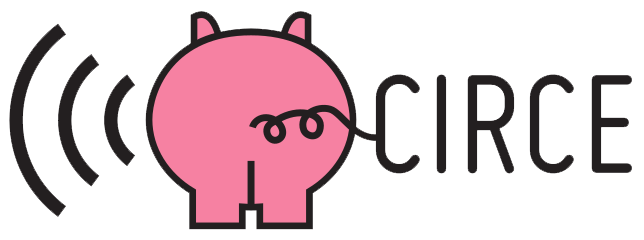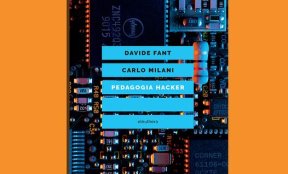by Davide Fant and Carlo B. Milani
Suggestions for a critical, ecological and free distance learning
this article is published in "Formare... a distanza?", II edizione, C.I.R.C.E. novembre 2020

The English organic is translated by the Italian bio, but the term
retains the organic root, which refers to the organism. In distance learning
we are immersed in complex environments that we would like to push in a more bio,
a more bio-organic direction. Inhabiting those spaces in a critical,
free, ecological way is a challenge of our times. On the whole we aim to
limit the automatic and automated interactions with machines in order to
expand the margins of non-automated interaction.
No, it is not a question of pitting humans against machines but of choosing how to
build convivial relationships through the development of appropriate technologies.
This is what we try to do with hacker pedagogy.
The following are some of the suggestions that have emerged in the
pages of this book. We have divided them into four categories
main categories: stay with the problem, people first,
creativity and critical thinking, and, finally, Educaton at a distance
does not mean videochat.
1. Stay with the problem (the attitude)
Beware of the 'fix-it-all' technique
Mass industrial technologies come to us with a strong ideological background,
although hardly ever explicitly. The assumption of technological ideology is simple:
every situation is a problem to be solved by a technical solution. The platforms for
distance learning, but also simple videochat, share this assumption.
According to this paradigm educators, teachers, trainers in the
conditions of having to work at a distance have to "simply" learn to
use the right apps, and of course to use them well.
Automatically, almost by magic, this "simple" use of the "right" tools
will solve the problem... of distance, didactics, training and so on. Automagically
Instead of indulging in the correct procedure, we think instead that trying to inhabit
discomfort, even the discomfort of distance, by appealing to our creative resources,
is a more generative starting point. Before launching into an online tutorial,
before rushing to a geeky friend, it is essential to stop, to connect with the problem,
to re-connect with ourselves and with the people towards whom we have training responsibilities.
Using previous skills, not disowning them in the digital environment, re-purposing them with a creative approach, and "do it yourself"
Your history, your competences, any of your resources can be useful
in distance learning. We do not lose who we are just because we are behind a screen.
But sometimes we are in danger of forgetting this, in search of the "miracle app".
We try to remember that everything we are and have can be useful, interesting, fun
even at a distance. Capabilities, doubts, impulses, weaknesses... in the digital context
we should not put them aside, as if we were in another dimension, outside ourselves.
As trainers, we want to start from what we, from our experience, consider essential in
the educational/training relationship and from our creativity. Dialoguing and, why not,
clashing and litigating with the machines is a key prerequisite for going in the direction
we consider important by keeping "the bar straight".
It is essential to try to adapt one's work without saying a priori that
"it is impossible". During the months of lockdown we have seen
teaching situations brought back online that were unthinkable before:
guided imaginations, theatrical exercises, dance choreographies,
cooking workshops... The greatest quality then becomes that of
"learning to unlearn" the classic working methods in order to rediscover
the heart of our approach, method, content, and re-invent them in the
on-line mode. It will certainly not be the same, but interesting things can happen.
A simple example, among others in this book, is when Agnese Trocchi
(Raccontare -- E i genitori?) tells of how the sociometry, a typical tool of
psychodramatic work in presence, were re-invented using simply a
pad during hacker pedagogy workshops at a distance.
Relating with elasticity (and transgression) to institutional expectations
Marta Milani, in her account of the re-invention of Italian L2 courses
at a distance (Clinamen: Italian without confinement) points out that
the fact of being outside an institutional framework determines for them
"a highly privileged situation". The same cannot be said for school
teachers: the institution does not compromise in respect with the
programme, and, even at the time of live videochat, it remains
attached to the classic evaluation methods.
The constraints on those who are forced to do distance learning,
however, can also be self-imposed: many trainers and educators
feel responsible for replicating models that are more or less imposed
from above, so much so that they find it hard to step back from them,
even in emergency situations.
In order to make distance learning as functional as possible, it is
often essential to break out of these external and/or self-induced
constraints and to distance oneself from "having to do" and reset
one's coordinates. The working time in a synchronous situation
(sharing the same space-time and focus of attention), the emotional
condition, the possibility to use didactic tools are different; therefore
also the objectives and priorities must be different.
This does not mean that we have to 'aim low', but we have to reset,
even without asking permission. We have to start again
from what is essential, from what you can give the most to the people
you have educational responsibilities towards, beyond what is previously
written on paper. If we want to create, we have to act fast, even a bit
like illegal immigrants, slipping through the grids of the institution and of our rigidities.
2. People first
Use face-to-face time as much as possible to build trust with the trainers and between group members
At a distance we are still us, even if mediated by machines and platforms.
That is why the groups that functioned best at a distance during the lockdown
were able to build on solid relationships built in presence. So when a course is
designed in blended mode (mixed presence and distance), or when it is at risk of
undergoing long periods of online-only for reasons of force majeure, it is important
to use the moments of physical encounter for activities that build trust, fellowship,
and authentic and meaningful relationships.
This suggestion can be useful when working with groups with
members who are used to long periods of absence, such as young
people at risk of social withdrawal. Paying particular attention to the
construction of the relationship with them when they are present can
support the continuity of the relationship and the formative work in
moments of "crisis" when the adolescent will not be able to attend
school or the service because we will be forced to activate a formative
work at a distance.
The care of the social bond is typical of resilient communities; it is a
form of mutual support, if we look closely: when the unexpected happens,
the 'catastrophe'... the experienced collaboration and closeness between
people becomes the first lever to face the situation.
Taking care of the individual relationship
Although we are used to carrying out our training work in groups,
in cases of forced distance it is important to implement one-to-one
communication.
This is because in face-to-face group situations there is always the
possibility of communicating individually between people; there are
unstructured moments in which one can meet and have a chat, there
is the possibility of meeting glances, of addressing more or less verbal
messages during the activity, even in the midst of many people.
In digital interactions all this becomes much more difficult.
Here are a few tricks that may prove useful:
- combine group videochat with regular individual meetings: a laborious task but one which,
- as described in the Inventing section, has proved to be of fundamental importance for those who have started it
- sending periodic individual sms or whatsapp messages with very personalised content
- giving the personal mobile phone number of the reference operator to the young people most at risk
of being removed.
It is well supported by experience to what extent the quality of the individual work
then reverberates in the group: if the leader knows the reflections, thoughts,
states of mind of the young people, he can, with sensitivity and delicacy,
bring them back into the context of the group meeting, and at the same time
avoid inappropriate gaffes and overstretching.
Finding unusual ways to make people feel that you are close by
Sending messages or making individual calls is a way to make learners feel
close to us, to tell them "you matter to me" beyond the formal mandate of group
learning. We can then reinforce this message through small gestures, undue
"gifts". For example, in the Unique Year (see the Inventing section), the
adolescents greatly appreciated the care with which the material they produced
at home was enhanced, formatted, transformed, remixed by the trainers without
it being part of their "training duties". This contributed to creating greater harmony
and connection even at a distance.
In the same context, it was experienced how a "poetic dialogue" made up of
listening to oneself and listening to the other, reciprocal and symmetrical
between learner and trainer created new proximities and alliances.
Putting the learner at the centre. What needs do they have? You can only learn at a distance if you are strongly motivated to do so.
Learning at a distance requires great motivation; being there in the
digital environment is tiring, learners are there if they feel it is worth it.
It may therefore be useful to propose activities that respond to their needs
and desires, that help them make sense of their present experience, that are
not perceived as an attempt to "fill up their time", or to inculcate content that is
not relevant to them.
Customising proposals, channels, training styles
The use of digital technologies does not impact on people's experience
in the same way. Different experiences suggest different options for
different learners, either in using a wider spectrum of platforms and
applications or in using the same platform. In the latter case, several
of the contributions reported here reiterate the importance of leaving
freedom in the use of videochat, which can be used in the audio-video
option but also only audio, or only text chat: an effective solution,
but little used in schools, which in most cases force their students
to show themselves in webcam, putting the need for control before
the well-being of the student, and the consequent learning results.
3. Maintaining a critical and creative approach with applications and platforms
We pay attention to the setting generated by applications, to the 'gentle nudging'.
Technical devices (machines, software, platforms, etc.) are not neutral, the bearers of an elsewhere outside of time and space, valid for everyone, always and in any case. Quite the opposite: they create a setting, they are bearers of epistemological and pedagogical approaches!
The moment we uncritically rely on the execution, on the application, the platform-machine, in a "gentle" way and maybe unconsciously for us, leads us in its direction, creates its own setting, a situation with specific rules and characteristics that could be very different from the one we consider useful, to work with children or adults, with these people who are different from all the others, with whom we have a privileged and unique relationship.
Moreover, it often happens that the more we learn to 'use software well', the more we conform to its 'gentle push'. It is a form of conformism, or rather of mutual conditioning between humans and machines. Nothing to do with conviviality
So it is that classroom teachers with little inclination towards rigid assessment have been guided by Google Classroom to assess through closed-ended tests, quizzes in which the reflective component is completely sacrificed in favour of the cognitive and mnemonic one. Similarly creative educators have reduced their activity to contests, challenges, production of nice memes that could work well with the like game of social networks.
It is crucial to be aware of the direction in which the platform's 'inclined plane' leads us, its 'demon' that has specific characteristics, interacts with our weaknesses, strengths and character. Awareness of our respective characters will help us to activate the appropriate countermeasures.
Making small software hacks
A way to resist the 'software demon', and, by collaborating, push the application to go in the direction we consciously wish consciously want, is to activate small hacks, i.e. changing the rules of the game, using features of the application born for a specific purpose, diverting them towards another more congenial objective. A very simple but effective example is to use the Zoom boxes (common to many videochat software) dedicated to the user's name in order to write. Not name, but hacker nicknames, adjectives and metaphors that represent us at that moment, or even mini-poems.
On the hack route, a very interesting experience was the use of Fortnite by a group of educators (the Fano Street Unit) to work with young people at risk of social withdrawal. Their hack was to modify the way victory was assigned. In this way, the boys' chances of winning were overturned, allowing even those who had never played the game to have fun and become 'competitive'. A competition whose rules do not respect the standard: knowing the specifics of the Fortnite demon you can use its characteristics without having to conform to the "right" use.
Free/Libre Open Source Software
Digital platforms and tools are not all the same. The ones we prefer are often light, not very resource-intensive; they are multiple, because they tend to do one thing well and not offer a one-size-fits-all solution; they often do not ask us for a login or password, and when they do we know where we are entering, who we are at when we access a given service; they do not collect data and metadata from our activities to profile us and offer us personalised advertising and products.
In this booklet Nextcloud, Jitsi, Etherpad come up often, but there are many others. They are F/LOSS, i.e. programmes that can be modified to help expand personal and collective freedoms through the digital world. They are certainly not free: they cost time and energy to learn how to deal with them, sometimes money if we are not able to manage them ourselves. Because if the software is free, the goods are ourselves, with our tastes, our habits, our relationships.
This is all the more true for e-learning platforms: as Graffio explains (section Didactics), the teaching method is bent by proprietary platforms, precisely because they are not neutral tools at our service, but bearers of economic interests in the first place. Not to mention the fact that if they store users' personal data in the United States, they do not respect the legislation in force throughout Europe on privacy (GDPR), as declared by the European Court of Justice.
Exploring the web. The web can also be an experiential learning space with its own advantages. Doing interviews.
Cyberspace is also a place for experiential learning. It is a territory that can be explored, that can be crossed with a critical eye, asking questions, constructing meanings. If we are forced to meet in that territory a wise thing to do is to focus on discovering it.
As suggested by the "journey to the edge of the darkweb" and the story on the hacker pedagogy workshops for parents (section Recounting), one can take advantage of the training and educational work at a distance to do meta-learning on the web; in fact, as the parents involved in this project themselves say, "we are already in the world we want to learn to know and understand".
Experiential meta-learning can be done in any situation. Even working with teenagers, one can explore together the world of social networks, the applications one uses, the feelings one experiences together when meeting in the digital world. Thus, in the experience of the Italian language school with adults and the elderly presented by Marta Milani, we reflect starting from digital devices and platforms on the meanings and origins of lexical terms used in the IT environment.
4. Distance learning is not video chat training
We limit our presence in digital environments. It is also a question of ecology: environmental, mental, relational.
One thing that is certain is that the rhythm of the machine is not the rhythm of the human. So we have to learn to be cautious in the space of the machine, particularly when machine space is run by massive platforms. Human bodies suffer from the stress speeds of the massive digital, compressed and incessant amount of stimuli. In an age where we are always connected, especially adolescents, it is very important to be able to make the most of the moments of "disconnection", of distancing oneself from screens.
Here are two small possible hacks to keep video time down, aimed particularly at training with teenagers but applicable more generally.
Firstly, it is healthy to have short video chats. One idea can be to have a short live moment, give a delivery, a task, and then disconnect to reconnect later for a moment of restitution. This also helps to give a "rhythm" to the pupils' time without over-stretching them.
It is also possible, during a video chat session, to propose moments in which each person moves away from the monitor to listen only to the voice of the person speaking, or to do brief unplugged activities, in effect disconnected even though the connection is active.
Rarely spending time online is also helpful in reducing the digital divide. Those without adequate devices and fast connections will experience more fatigue during prolonged online activities. Once again, the connected world tends to amplify the inequalities that exist in the disconnected world.
Warning! Spending less time online does not mean that minds, bodies, 'souls' are less connected. What is crucial is the quality of the relationship, not the quantity of monitor-minutes! Otherwise, the idea of setting that quantifies, that automatically tells us how long we have been connected as if that much were a guarantee of success would pass.
Other lessons are possible to improve the quality of our training experiences.
Enhancing asynchronous interaction.
It is useful to reduce chat moments and instead enhance moments of asynchronous interaction. In traditional training they are reduced to "homework" but, inspired by the flipped classroom approach, we can enhance the value of individual moments with learning stimuli, which is then socialised and reworked in the group and with the trainer (the moment of synchronous interaction). Going in this direction means exploiting the constraint of distance to support learner autonomy and invite them to make an effort to directly confront the learning themes directly, avoiding the passive posture often generated by the frontal lesson.
The importance of lowering noise
We try to send as few notifications as possible. Notifications are almost literally "pins", which prick the skin, stimulate the brain and maintain a state of continuous tension, a kind of attention that does not generate depth and intensity but performative stress. In stressful situations, meaningful learning is substantially affected.
Less may concern the use of fewer channels in a multimedia situation, with the aim of reducing the number of stimuli and thus favouring the focusing of attention. For example in video chat you can decide not to use the chat, or to close the camera and thus remove the camera and the monitor stimulus.
There are no general rules that apply to everyone at all times. writing chat is no less emotionally involving than video: On the contrary, if the aim is to create intimacy and trust, chat can play a fundamental role.
The most underrated 'hot' channel: the voice
It is important to remember that voice is a warmer medium than video. It doesn't mean that emotionally images are less involving, but voice is more effective when we want to create intimacy (in the same way that black and white images are warmer than colour images): in the half-light, in a 'night-time setting'. In the semi-darkness, in the darkness the contours of the images blur, the boundaries are blurred and this environment protects us and makes us feel more comfortable. Translated into a education at a distance, it can be important to make use of (live) radio, the podcast (a recording that can be listened to deferred), but also simply re-evaluate the 'old' telephone call, face-to-face, "voice only.
In this respect, a good microphone is important. More than the resolution of the video. If we want to make a leap in technical quality, here is a good investment: appropriate microphones, directional if they are used to pick up a a single voice, ambient and panoramic if they are to pick up several voices and sounds. Even with a laptop computer, an external USB microphone can make the difference between a noisy and disturbing session and a more pleasant experience.
Distance learning without digital?
We close this 'introduction' with a provocation:*Is it possible to do distance learning without digital?
When schools were closed at the end of February, but the lockdown had not yet been triggered, some teachers went round their students' homes to bring them "parcels" with materials for distance learning, or letters to communicate their closeness and give them some advice on how to live through that difficult time.
With this suggestion we certainly do not want to diminish the fundamental role that digital technology has had and is having in such a difficult period. We just want to remind you that digital should not cancel out our analogue wisdom and creativity, it is an (often useful) presence in a world that is so much more. For us, this is what being a hacker is all about, knowing how to deal with machines creatively without being used by them, without it becoming the all-encompassing game square that stifles our generativity.


